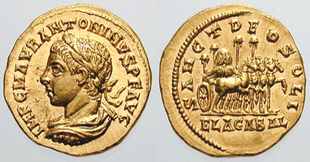
Elagaballium
Encyclopedia

Elagabalus
Elagabalus , also known as Heliogabalus, was Roman Emperor from 218 to 222. A member of the Severan Dynasty, he was Syrian on his mother's side, the son of Julia Soaemias and Sextus Varius Marcellus. Early in his youth he served as a priest of the god El-Gabal at his hometown, Emesa...
, located on the north-east corner of the Palatine Hill
Palatine Hill
The Palatine Hill is the centermost of the Seven Hills of Rome and is one of the most ancient parts of the city...
. During Elagabalus' reign from 218
218
Year 218 was a common year starting on Thursday of the Julian calendar. At the time, it was known as the Year of the Consulship of Severus and Adventus...
until 222
222
Year 222 was a common year starting on Tuesday of the Julian calendar. At the time, it was known as the Year of the Consulship of Antoninus and Severus...
, the Elagabalium was the center of a controversial religious cult, dedicated to Deus Sol Invictus
Sol Invictus
Sol Invictus was the official sun god of the later Roman empire. In 274 Aurelian made it an official cult alongside the traditional Roman cults. Scholars disagree whether the new deity was a refoundation of the ancient Latin cult of Sol, a revival of the cult of Elagabalus or completely new...
, of which the emperor himself was the high priest.
History
The temple was a colonnaded structure some 70 metres by 40 metres, in front of the Colosseum, within a colonnaded enclosure. The temple platform was originally built under DomitianDomitian
Domitian was Roman Emperor from 81 to 96. Domitian was the third and last emperor of the Flavian dynasty.Domitian's youth and early career were largely spent in the shadow of his brother Titus, who gained military renown during the First Jewish-Roman War...
between 81
81
Year 81 was a common year starting on Monday of the Julian calendar. At the time, it was known as the Year of the Consulship of Silva and Pollio...
and 96
96
Year 96 was a leap year starting on Friday of the Julian calendar. At the time, it was known as the Year of the Consulship of Valens and Vetus...
, and may have been a place of worship to Jupiter
Jupiter (mythology)
In ancient Roman religion and myth, Jupiter or Jove is the king of the gods, and the god of the sky and thunder. He is the equivalent of Zeus in the Greek pantheon....
. The remnants of this terrace are still visible today at the north-east corner of the Palatine Hill
Palatine Hill
The Palatine Hill is the centermost of the Seven Hills of Rome and is one of the most ancient parts of the city...
.
When Elagabalus became emperor in 218
218
Year 218 was a common year starting on Thursday of the Julian calendar. At the time, it was known as the Year of the Consulship of Severus and Adventus...
the temple was expanded and rededicated to the god El-Gabal, the patron deity of his homeplace Emesa in Syria
Syria
Syria , officially the Syrian Arab Republic , is a country in Western Asia, bordering Lebanon and the Mediterranean Sea to the West, Turkey to the north, Iraq to the east, Jordan to the south, and Israel to the southwest....
. Elagabalus renamed the god Deus Sol Invictus
Elagabalus Sol Invictus
-Cult:Elagabalus was initially venerated at Emesa in Syria. The name is the Latinized form of the Syrian Ilāh hag-Gabal, which derives from Ilāh "god" and gabal "mountain") compare gəbul and jabal), resulting in "the God of the Mountain" the Emesene manifestation of the deity. The cult of the...
and personally led a cult that worshipped this deity. Deus Sol Invictus was personified by a conical black stone
Baetylus
Baetylus is a Semitic word denoting a sacred stone, which was supposedly endowed with life. According to ancient sources, these objects of worship were meteorites, which were dedicated to the gods or revered as symbols of the gods themselves...
, which has been suggested to have been a piece of meteorite
Meteorite
A meteorite is a natural object originating in outer space that survives impact with the Earth's surface. Meteorites can be big or small. Most meteorites derive from small astronomical objects called meteoroids, but they are also sometimes produced by impacts of asteroids...
rock.
After Elagabalus' death the temple was again dedicated to Jupiter by Severus Alexander. A second, smaller temple to the god El-Gabal was built where the church of Santa Croce in Gerusalemme
Santa Croce in Gerusalemme
The Basilica of the Holy Cross in Jerusalem is a Roman Catholic parish church and minor basilica in Rome, Italy. It is one of the Seven Pilgrim Churches of Rome....
now stands.
The cult of Elagabalus

Septimius Severus
Septimius Severus , also known as Severus, was Roman Emperor from 193 to 211. Severus was born in Leptis Magna in the province of Africa. As a young man he advanced through the customary succession of offices under the reigns of Marcus Aurelius and Commodus. Severus seized power after the death of...
, sun worship had increased throughout the Empire. Elagabalus saw this as an opportunity to set up his god, El-Gabal, as the chief deity of the Roman pantheon
Dii Consentes
The Dii Consentes were a list of twelve major deities, six gods and six goddesses, in the pantheon of Ancient Rome. Their gilt statues stood in the Forum, later apparently in the Porticus Deorum Consentium....
. El-Gabal, renamed Deus Sol Invictus
Sol Invictus
Sol Invictus was the official sun god of the later Roman empire. In 274 Aurelian made it an official cult alongside the traditional Roman cults. Scholars disagree whether the new deity was a refoundation of the ancient Latin cult of Sol, a revival of the cult of Elagabalus or completely new...
or God the Undefeated Sun, was placed over even Jupiter. As a sign of the union between the two religions, Elagabalus gave either Astarte
Astarte
Astarte is the Greek name of a goddess known throughout the Eastern Mediterranean from the Bronze Age to Classical times...
, Minerva
Minerva
Minerva was the Roman goddess whom Romans from the 2nd century BC onwards equated with the Greek goddess Athena. She was the virgin goddess of poetry, medicine, wisdom, commerce, weaving, crafts, magic...
, Urania
Urania
Urania was, in Greek mythology, the muse of astronomy. Some accounts list her as the mother of the musician Linus. She is usually depicted with a globe in her left hand. She is able to foretell the future by the arrangement of the stars...
, or some combination of the three, to El-Gabal as a wife. Herodian
Herodian
Herodian or Herodianus of Syria was a minor Roman civil servant who wrote a colourful history in Greek titled History of the Empire from the Death of Marcus in eight books covering the years 180 to 238. His work is not entirely reliable although his relatively unbiased account of Elagabalus is...
writes that Elagabalus forced senators to watch while he danced around the altar of El-Gabal to the sound of drums and cymbals, and that each summer solstice
Solstice
A solstice is an astronomical event that happens twice each year when the Sun's apparent position in the sky, as viewed from Earth, reaches its northernmost or southernmost extremes...
became a great festival to El-Gabal popular with the masses because of its widely distributed food. During this festival, Elagabalus placed El-Gabal on a chariot
Chariot
The chariot is a type of horse carriage used in both peace and war as the chief vehicle of many ancient peoples. Ox carts, proto-chariots, were built by the Proto-Indo-Europeans and also built in Mesopotamia as early as 3000 BC. The original horse chariot was a fast, light, open, two wheeled...
adorned with gold and jewels, which he paraded through the city, after which he threw gifts into the Roman crowds:
After thus bringing the god out and placing him in the temple, Heliogabalus performed the rites and sacrifices described above; then, climbing to the huge, lofty towers which he had erected, he threw down, indiscriminately, cups of gold and silver, clothing, and cloth of every type to the mob below.
The most sacred relics from the Roman religion were transferred from their respective shrines to the Elagabalium, including the Great Mother
Cybele
Cybele , was a Phrygian form of the Earth Mother or Great Mother. As with Greek Gaia , her Minoan equivalent Rhea and some aspects of Demeter, Cybele embodies the fertile Earth...
, the fire of Vesta
Vesta
-Astronomy:* 4 Vesta, second largest asteroid in the solar system, also a proto-planet, named after the Roman deity* Vesta family, group of asteroids that includes 4 Vesta- Places :* Monte Vesta, Lombardy, Italy* Temple of Vesta, Rome, Italy...
, the Shields
Ancile
The Ancile, in ancient Rome, is the legendary buckler shield of the god Mars, said to have fallen from heaven, upon Numa Pompilius. At the same time, a voice was heard which declared that Rome should be mistress of the world while the shield was preserved. The Ancile was, as it were, the palladium...
of the Salii
Salii
In ancient Roman religion, the Salii were the "leaping priests" of Mars supposed to have been introduced by King Numa Pompilius. They were twelve patrician youths, dressed as archaic warriors: an embroidered tunic, a breastplate, a short red cloak , a sword, and a spiked headdress called an apex...
and the Palladium
Palladium (mythology)
In Greek and Roman mythology, a palladium or palladion was an image of great antiquity on which the safety of a city was said to depend. "Palladium" especially signified the wooden statue of Pallas Athena that Odysseus and Diomedes stole from the citadel of Troy and which was later taken to the...
. Ancient history records lurid tales of human sacrifice
Human sacrifice
Human sacrifice is the act of killing one or more human beings as part of a religious ritual . Its typology closely parallels the various practices of ritual slaughter of animals and of religious sacrifice in general. Human sacrifice has been practised in various cultures throughout history...
taking place inside the temple, involving children which were collected all over Italy
Italica
The city of Italica was founded in 206 BC by the Roman general Publius Cornelius Scipio Africanus in order to settle Roman soldiers wounded in the Battle of Ilipa, where the Carthaginian army was defeated during the Second Punic War...
from the richest and noblest families. The religious excesses of Elagabalus' reign eventually contributed to his demise. On March 11, 222, Elagabalus was killed by members of the Praetorian Guard
Praetorian Guard
The Praetorian Guard was a force of bodyguards used by Roman Emperors. The title was already used during the Roman Republic for the guards of Roman generals, at least since the rise to prominence of the Scipio family around 275 BC...
, and replaced by his cousin Severus Alexander. Elagabalus' religious edicts were reversed, and the statues which had been moved to the Elagabalium were restored to their original shrines.
External links
- The Elagabalium, history and description from livius.org

